Trees Birds Mammals Fish Amphibians Reptiles
Wild Algarve
Bookshop
Dactylorhiza purpurella - Northern Marsh-orchid & Dactylorhiza purpurella var. cambrensis
Phylum: Magnoliophyta - Class: Liliopsida - Order: Orchidales - Family: Orchidaceae
Dactylorhiza purpurella - NorthernMarsh-orchid
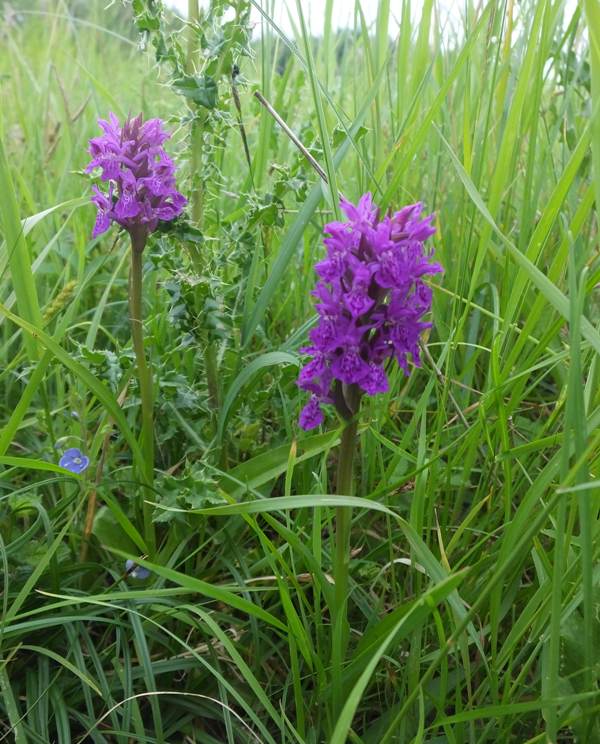
Above: Northern Marsh-orchid at Marfield Wetlands, Yorkshire UK.
Very few cameras can do justice to the intense dark purple colour of the Northern Marsh-orchid.
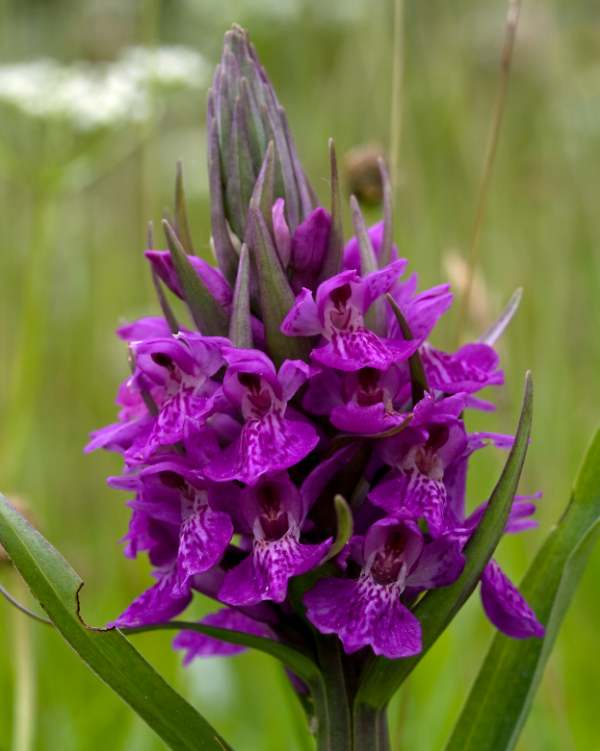
Description
The Northern Marsh-orchid grows to between 15 to 30cm, and its short and somewhat stumpy appearance is one of its main distinguishing features, particularly in the sites where it occurs with Southern Marsh-orchid Dactylorhiza praetermissa which is taller - typically around 50cm. The leaves of Dactylorhiza purpurella are usually unmarked or sometimes faintly marked. The exception to this is Dactylorhiza purpurella var. cambrensis, which has darkly spotted leaves and bracts and which occurs on the coast of Wales from Cardigan Bay up to and including Anglesey in North Wales - see below.
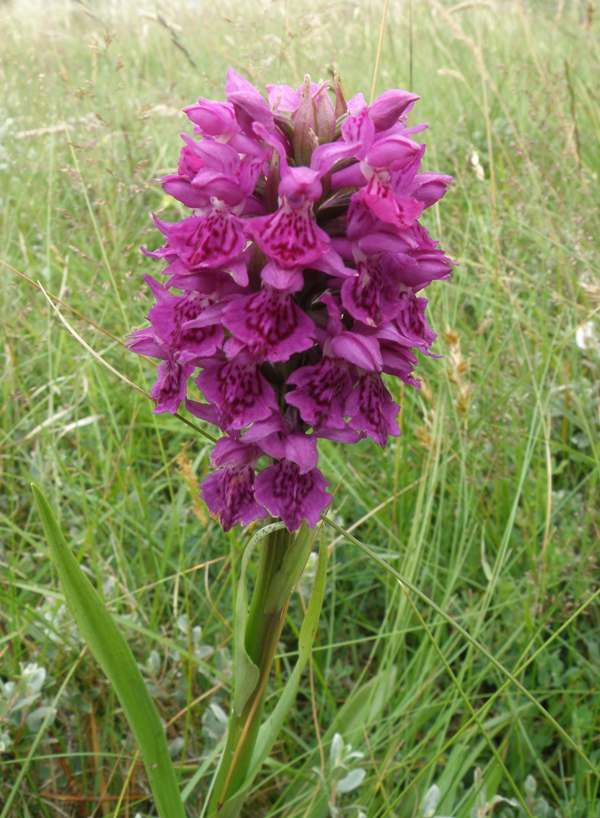
The inflorescence of the Northern Marsh-orchid often has a flattened top and is smaller and with fewer and narrower flowers than the Southern Marsh-orchid. The lips of the flowers of the Northern Marsh-orchid are distinctly angular (almost diamond-shaped) and barely lobed whereas those of the Southern Marsh-orchid are rounded, slightly folded back and with a pronounced central lobe.
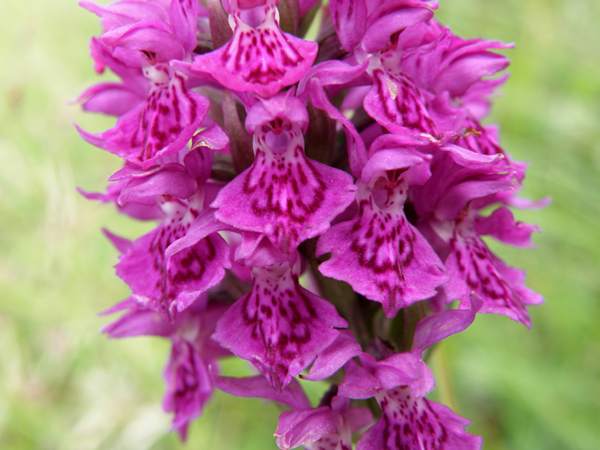
The diamond-shaped lip of the Northern Marsh-orchid
Distribution
The range of this orchid is predominantly in the northern part of the UK extending from the West Wales coast and up into Scotland and the Western Isles. It is also found in Northern Ireland, but is rare and very localised in Southern Ireland. On mainland Europe this orchid is known to occur in Sweden, Denmark and Norway.
Habitat
Northern Marsh-orchids are found in damp coastal dune slacks in Wales and Scotland. In the Outer Hebrides they grow in large colonies in the machair (sea meadows).
In Norway and Sweden this orchid also occurs on the western coasts in dune slacks and is given the name Strandnycklar - 'strand' being the Swedish word for beach.
Flowering times
Dactylorhiza purpurella flowers from late May into July.
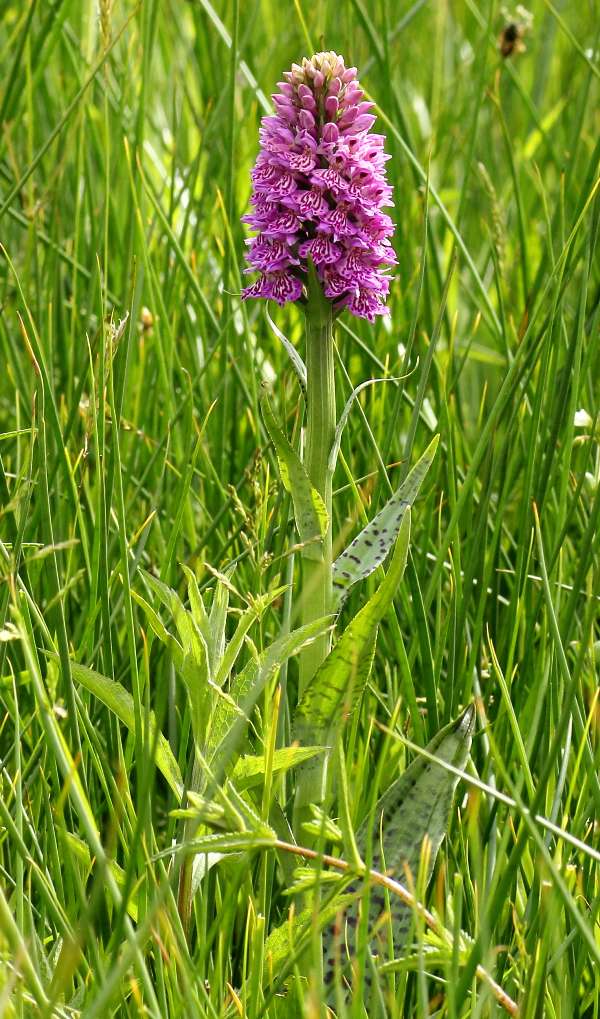
Dactylorhiza purpurella var. cambrensis growing in a dune slack in Anglesey, North Wales. The leaves and bracts of the plant are marked with dull purple spots.
Dactylorhiza purpurella var. cambrensis
This variety of the Northern Marsh-orchid, sometimes referred to as the Western Marsh-orchid, occurs on the coast of Wales from Cardigan northwards, and is mainly differentiated by the dark purple marks on the lips and the bracts of the plant, which vary greatly in intensity. The flowers are paler in colour and their lips have a distinct lobe not present in the Northern Marsh-orchid. This subspecies is also recorded from western Scotland.
Newborough Warren National Nature Reserve in Anglesey is one of the places where this Northern Marsh-orchid variety is regularly recorded, and it is also found in the dune slacks around Aberffraw which is slightly further around the Anglesey coast towards Treaddur Bay.
Plants are also known to occur in meadows near to the coast of Cardigan Bay.
Flowering times
Late May to July
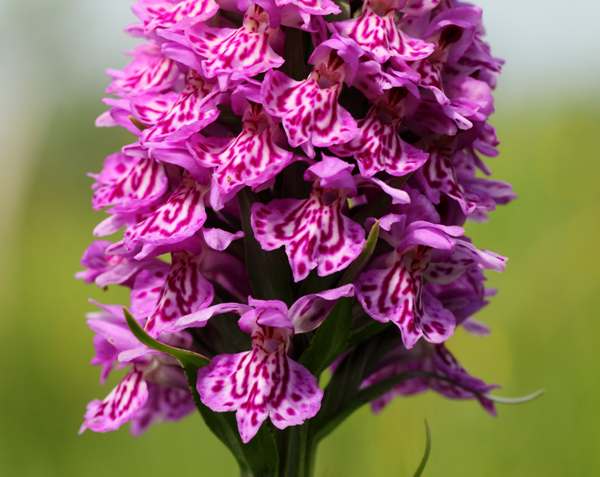
A close-up picture of the inflorescence of Dactylorhiza purpurella var. cambrensis reveals the heavily marked flowers with distinct central lobes on their lips.
Subspecies, Varieties and Hybrids
Subspecies:
Dactylorhiza purpurella subsp. cambrensis occurs in Wales and is described above.
Varieties:
Dactylorhiza purpurella var. pulchella has flower lips with spots and dashes rather than loops; it is ecorded in Scotland.
Dactylorhiza purpurella var. crassifolia has broader leaves and the flowers have larger lips; it is rare.
Dactylorhiza purpurella var. maculosa has overall small dots on the leaves and the lip of the flower is paler; it is recorded from Scotland.
Dactylorhiza purpurella var. albiflora has white flowers.
Dactylorhiza purpurella var. atrata is hyperchromatic and has very dark flowers and darkly marked leaves; it is known from a heavily contaminated location near Hartlepool.
Hybrids:
Dactylorhiza x formosa is a hybrid with Heath Spotted-orchid Dactylorhiza maculata.
Dactylorhiza x venusta is a hybrid with Common Spotted-orchid Dactylorhiza fuchsii.
Dactylorhiza x viridella is a hybrid with Frog Orchid Dactylorhiza viridis.
Dactylorhiza x insignis is a hybrid with Southen Marsh-orchid Dactylorhiza praetermissa.
Dactylorhiza x latirella is a hybrid with Early Marsh-orchid Dactylorhiza incarnata.
Intergenetic hybrids:
X Dactylodenia varia is a hybrid with one of the Fragrant Orchids Gymnadenia spp.
Etymology
The genus name Dactylorhiza means 'finger-like roots', while the specific epithet purpurella means slightly purple', in the sense of 'pale purple'.
Reference sources
The Plant List
Sue Parker (2023) Wild Orchids of Wales - how, when and where to find them; First Nature e-book (Amazon Kindle format)
Anne and Simon Harrap (2005) Orchids of Britain and Ireland; A&C Black
Pierre Delforge (2005) Orchids of Europe, North Africa and the Middle East; A&C Black
Den Nordiska Floran (1992) Bo Mossberg, Stefan Ericsson and Lennart Stenberg; Wahlstrom & Widstrand
Pictures: Elaine Hagget...
Sue Parker's latest ebook is a revised and enlarged edition of Wild Orchids in The Burren. Full details here...
Buy it for just £5.95 on Amazon...
Sue Parker's new ebook is a comprehensive and fully revised edition of her acclaimed field guide to the Wild Orchids of Wales. Full details here...
Buy it for just £5.95 on Amazon...
Sue Parker's 5-star acclaimed field guide to the Wild Orchids of the Algarve is now available as an ebook. Full details here...
Buy it for just £5.95 on Amazon...
Please Help Us: If you have found this information interesting and useful, please consider helping to keep First Nature online by making a small donation towards the web hosting and internet costs.
Any donations over and above the essential running costs will help support the conservation work of Plantlife, the Rivers Trust and charitable botanic gardens - as do author royalties and publisher proceeds from books by Pat and Sue.